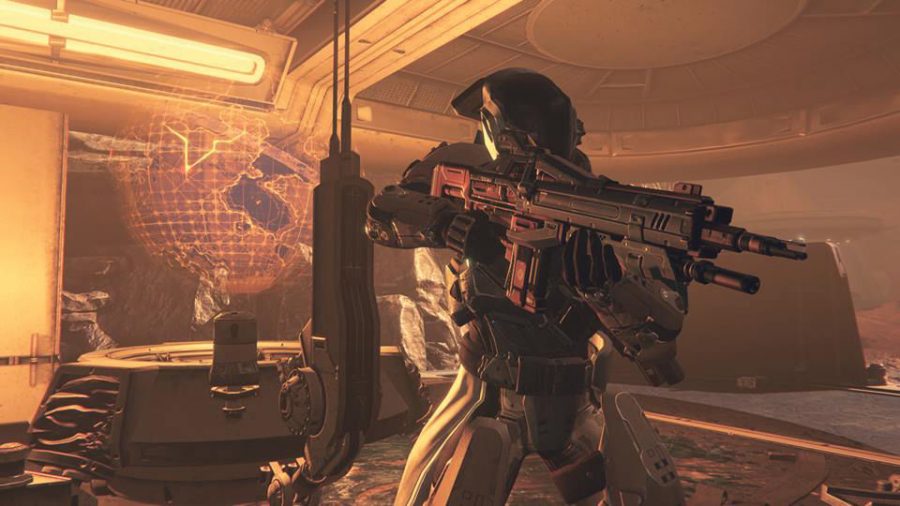‘Destiny’ nails gameplay, flubs storyline and ‘social experience’
October 15, 2014
“Destiny”
Released: Sept. 9, 2014
Available on: PlayStation 3, PlayStation 4, Xbox 360, Xbox One
Developer: Bungie
Grade: B
A tiny, gray, multifaceted Ghost flies through the ruins of the Cosmodrome in Old Russia, Earth. The Ghost’s artificial intelligence scans overgrowth, collapsed cars and barren steppe before it locates its target. The Ghost emits a sphere of blue light, as a soft, yet expectant, return-to-hero score floats in and out of the background. “You’re alive!” he exclaims in a familiar voice. “You’ve been dead a long time.”
The “you” this Ghost — voiced by “Game of Thrones” star Peter Dinklage — refers to is actually you, the player, who just spent a few minutes on a character creation screen designing an avatar, referred to as “Guardian.” You’re only viewed during brief trysts to the Tower, a space station and hub world. “Destiny” flings you quickly into the first-person action with little regard to narrative. Soon enough, it no longer matters what the game’s story is because its gameplay takes precedence.
The hype leading up to its launch promised huge numbers, and Bungie, veterans of the “Halo” series, delivered big time. “Destiny” earned $325 million worldwide in only five days, quickly dethroning “Watch Dogs” as the fastest selling new game IP in 2014. Now, little more than a month after its release, “Destiny” averages 3.2 million active players per day.
These numbers don’t make much sense, though, because according to its schemata, “Destiny” is just another space opera. Take the ships, aliens and technology out of “Star Wars” and “Star Trek,” couple it with the skill trees and classes of “Mass Effect” and the first-person shooter (FPS) gameplay of “Halo,” and you arrive at “Destiny.” Except for one important detail — it’s massively multiplayer online (MMO), which means those 3.2 million users all play together both cooperatively and competitively.
Common with most FPS games, the campaign mode lasts a painfully short amount of time — less than 10 hours. It teaches the basics: how to shoot, what to shoot at, how to gear up and where to gain reputation. It traverses the massive open world landscapes of post-apocalyptic Earth, the moon, Venus and Mars. While Earth is ravaged, the moon hosts an architecturally amazing underground temple and Venus, like her namesake, flushes with fertility. Transit speeds up once the player acquires his or her Sparrow, a motorcycle-like vehicle reminiscent of the speeder bikes from Endor.
Story missions follow a strict code, which always end with the Ghost hacking into some archaic technology while the Guardian fends off wave after wave of hordes, running and gunning enemies and eventually encountering a boss. Thankfully, the answer to the monotony is the Crucible, which mixes up the solo or co-op game with a dose of player versus player (PvP).
In the Crucible, four permanent game types appear. Clash is a 6v6 team deathmatch, Control is a 6v6 capture the flag, Rumble is a 6-player free-for-all and Skirmish is a 3v3 team deathmatch. Players enter the Crucible either solo or with the members of the current Fireteam — one to three-person teams formed by players. Fireteams make the game a lot more fun too, because forming one opens voice chat with other players.
But voice chat and Fireteams generate the most persistent problems. Voice chat is disabled in solo campaigning, Crucible play and the Tower, which is supposed to be a social hub. It only works when part of a Fireteam. But how does one join a Fireteam with no means of communication? “Destiny” lacks a keyboard option or alternate form of chat. Four emotes exist, but dancing with a stranger doesn’t immediately convey, “I want to join your team for the next mission.” Thankfully, the absence of voice chat in the Crucible makes trolling and harassment impossible, but the inability to communicate at all crafts a predicament for a game marketed as a “social experience.”
Another unfortunate aspect is that “Destiny” requires and obligates large-scale commitment postgame. Players need to grind for better gear in order to open up new content. They need to locate a Clan — the equivalent of Guilds — or a dependable Fireteam to proceed through this content. Finally, the ultimate challenge awaits in the Vault of Glass, a six-man raid full of difficult monsters, traps and bosses.
The future of “Destiny” will be a particularly dynamic one. Seasonal and limited-time events already trickle the gamespace (“The Queen’s Wrath,” “The Iron Banner” and “Salvage”), and an expansion titled “The Dark Below” is scheduled for release in December. If “Destiny” doesn’t bore from the outset, be prepared for the long-term undertaking.








